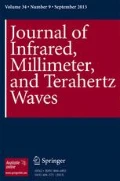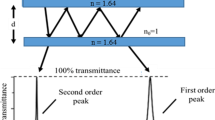Abstract
Recent years have seen an influx of applications utilizing 3D printed devices in the terahertz regime. The simplest, and perhaps most versatile, modality allowing this is Fused Deposition Modelling. In this work, a holistic analysis of the terahertz optical, mechanical and printing properties of 17 common and exotic 3D printer filaments used in Fused Deposition Modelling is performed. High impact polystyrene is found to be the best filament, with a useable frequency range of 0.1–1.3 THz, while remaining easily printed. Nylon, polylactic acid and polyvinyl alcohol give the least desirable terahertz response, satisfactory only below 0.5 THz. Interestingly, most modified filaments aimed at increasing mechanical properties and ease of printing do so without compromising the useable terahertz optical window.





Similar content being viewed by others
References
I. Gibson, D. Rosen, and B. Stucker, Additive manufacturing technologies: 3D printing, rapid prototyping and direct digital manufacturing, Springer, Berlin, 2015.
B. Bhushan and M. Caspers, An overview of additive manufacturing (3D printing) for microfabrication, Microsystem Technologies 23 (2017), no. 4, 1117–1124.
R.A. Lewis, Terahertz physics, Cambridge University Press, Cambridge, 2012.
C. Jördens, K.L. Chee, I.A.I. Al-Naib, I. Pupeza, S. Peik, G. Wenke, and M. Koch, Dielectric fibres for low-loss transmission of millimetre waves and its application in couplers and splitters, Journal of Infrared Millimeter, and Terahertz Waves 31 (2010), 214.
C. Goy, M. Scheller, B. Scherger, V. P. Wallace, and M. Koch, Terahertz waveguide prism, Optics Express 21 (2013), no. 16, 19292–19301.
L. Lo and R. Leonhardt, Aspheric lenses for terahertz imaging, Optics Express 16 (2008), no. 20, 15991–15998.
J. L. Coutaz, F. Garet, E. Bonnet, A. V. Tishchenko, O. Parriaux, and M. Nazarov, Grating diffraction effects in the THz domain, Acta Physica Polonica 107 (2005), no. 1, 26–37.
N. S. Stoyanov, T. Feurer, D. W. Ward, and K. A. Nelson, Integrated diffractive terahertz elements, Applied Physics Letters 82 (2003), no. 5, 674.
B. Zhang, Y. X. Guo, H. Zirath, and Y. P. Zhang, Investigation on 3-D-printing technologies for millimeter-wave and terahertz applications, Proceedings of the IEEE 105 (2017), no. 4, 723–736.
A. D. Squires, E. Constable, and R.A. Lewis, 3D printed terahertz diffraction gratings and lenses. Journal of Infrared, Millimeter, and Terahertz Waves 36 (2015), no. 1, 72–80.
W. D. Furlan, V. Ferrando, J. A. Monsoriu, P. Zagrajek, and E. Czerwinska, 3D printed diffractive terahertz lenses, M. Szustakowski. Optics Letters 41 (2016), no. 8, 1748–1751.
Z. Zhang, X. Wei, C. Liu, K. Wang, J. Liu, and Z. Yang, Rapid fabrication of terahertz lens via three-dimensional printing technology, Chinese Optics Letters 13 (2015), no. 2, 022201–022201.
S. F. Busch, M. Weidenbach, J. C. Balzer, and M. Koch. 3D Printed with, THz Optics TOPAS technology. Journal of Infrared, Millimeter and Terahertz Waves 37 (2016), no. 4, 303–307.
J. Suszek, A. Siemion, M. S. Bieda, N. Błocki, D. Coquillat, G. Cywiński, E. Czerwińska, M. Doch, A. Kowalczyk, N. Palka, A. Sobczyk, P. Zagrajek, M. Zaremba, A. Kolodziejczyk, W. Knap, and M. Sypek, 3-D-printed flat optics for THz linear scanners, IEEE Transactions on Terahertz Science and Technology 5 (2015), no. 2, 314–316.
M. Weidenbach, D. Jahn, A. Rehn, S. F. Busch, F. Beltrán-Mejía, J. C. Balzer, and M. Koch, 3D printed dielectric rectangular waveguides, splitters and couplers for 120 GHz, Optics Express 24 (2016), no. 25, 28968–28976.
M. Liang, W.-R. Ng, K. Chang, K. Gbele, M. E. Gehm, and H. Xin, A 3-D Luneburg lens antenna fabricated by polymer jetting rapid prototyping, IEEE Transactions on Antennas and Propagation 62 (2014), no. 4, 1799–1807.
S. Pandey, B. Gupta, and A. Nahata, Terahertz plasmonic waveguides created via 3D printing, Optics Express 21 (2013), no. 21, 24422–24430.
Z. Wu, W.-R. Ng, M. E. Gehm, and H. Xin, Terahertz electromagnetic crystal waveguide fabricated by polymer jetting rapid prototyping, Optics Express 19 (2011), no. 5, 3962–3972.
T. Ma, H. Guerboukha, M. Girard, A. D. Squires, and R. A. Lewis, 3D printed hollow-core terahertz optical waveguides with hyperuniform disordered dielectric reflectors, M. Skorobogatiy., Advanced Optical Materials 4 (2016), no. 12, 2085–2094.
W. J. Otter and S. Lucyszyn, Hybrid 3-D-printing technology for tunable THz applications, Proceedings of the IEEE 105 (2017), no. 4, 756–767.
D. W. Vogt and R. Leonhardt, 3D-printed broadband dielectric tube terahertz waveguide with anti-reflection structure, Journal of Infrared, Millimeter, and Terahertz Waves 37 (2016), no. 11, 1086–1095.
N. J. Karl, R. W. McKinney, Y. Monnai, R. Mendis, and D. M. Mittleman, Frequency-division multiplexing in the terahertz range using a leaky-wave antenna, Nature Photonics 9 (2015), 717–720.
N. Yudasari, J. Anthony, and R. Leonhardt, Terahertz pulse propagation in 3D-printed waveguide with metal wires component, Optics Express 22 (2014), no. 21, 26042–26054.
A. R. Phipps, A. J. MacLachlan, C. W. Robertson, L. Zhang, I.V. Konoplev, A.W. Cross, and A. D. R. Phelps, Electron beam excitation of coherent sub-terahertz radiation in periodic structures manufactured by 3D printing, Nuclear Instruments and Methods in Physics Research B 402 (2017), 202–205.
E. A. Gurvitz, S. A. Andronaki, S. I. Gusev, V. Y. Soboleva, Y. D. Nazarov, and M. K. Khodzitsky, Development of 3D anisotropic artificial dielectric metamaterial for THz frequency range. PIERS Proceedings, 2715–2718, 2014.
B. Zhang and H. Zirath. Metallic, 3-D printed rectangular waveguides for millimeter-wave applications, IEEE Transactions on Components, Packaging and Manufacturing Technology 6 (2016), no. 5, 796–804.
A. I. Hernandez-Serrano and E. Castro-Camus, Quasi-Wollaston-prism for terahertz frequencies fabricated by 3D printing, Journal of Infrared Millimeter, and Terahertz Waves 38 (2017), no. 5, 567–573.
H. Yi, S.-W. Qu, K.-B. Ng, and X. Bai, 3D Printed Millimeter-Wave and Terahertz Lenses with Fixed and Frequency Scanned Beam, IEEE Transactions on Antennas and Propagation 64 (2016), no. 2, 442–449.
J. Li, K. Nallappan, and H. Guerboukha, M Skorobogatiy. 3D printed hollow core terahertz Bragg waveguides with defect layers for surface sensing applications, Optics Express 25 (2017), no. 4, 4126–4144.
F. Zhou, W. Cao, B. Dong, T. Reissman, W. Zhang, and C. Sun, Additive Manufacturing of a 3D Terahertz Gradient-Refractive Index Lens, Advanced Optical Materials 4 (2016), no. 7, 1034–1040.
N. Yudusari, D. Vogt, J. Anthony, and R. Leonhardt, Hollow core terahertz waveguide fabricated using a 3D printer. 39th International Conference on Infrared, Millimeter and Terahertz waves (IRMMW-THz), 2014.
D. Vogt, J. Anthony, and R. Leonhardt, Metallic and 3D-printed dielectric helical terahertz waveguides, Optics Express 23 (2015), no. 26, 33359–33369.
D. Headland, W. Withayachumnankul, M. Webb, H. Ebendorff-Heidepriem, A. Luiten, and D. Abbott, Analysis of 3D-printed metal for rapid-prototyped reflective terahertz optics, Optics Express 24 (2016), no. 15, 17384–17396.
E. Castro-Aguirre, F. Iñiguez-Franco, H. Samsudin, X. Fang, and R. Auras, Poly(lactic acid)–mass production, processing, industrial applications, and end of life, Advanced Drug Delivery Reviews 107 (2016), 333–366.
K. M. Nampoothiri, N. R. Nair, and R. P. John, An overview of the recent developments in polylactide (PLA) research, Bioresource Technology 101 (2010), no. 22, 8493–8501.
R. M. Rasala, A. V. Janorkarc, and D. E. Hirt, Poly(lactic acid) modifications, Progress in Polymer Science 35 (2010), no. 3, 338–356.
F. Carrasco, P. Pagès, J. Gámez-Pérez, O. O. Santana, and M. L. Maspoch, Processing of poly(lactic acid) Characterization of chemical structure, thermal stability and mechanical properties, Polymer Degradation and Stability 95 (2010), no. 2, 116–125.
L.-T. Lim, R. Auras, and M. Rubino, Processing technologies for poly(lactic acid), Progress in Polymer Science 33 (2008), no. 8, 820–852.
I. Noda, M. M. Satkowski, A. E. Dowrey, and C. Marcott, Polymer alloys of nodax copolymers and poly(lactic acid), Macromolecular Bioscience 4 (2004), no. 3, 269–275.
M. Seidl, J. Safka, J. Bobek, L. Behalek, and J. Habr, Mechanical properties of products made of ABS with respect to individuality of FDM production process, Modern Machinery Science Journal 2 (2017), 1748–1751.
C. G. Ferro, S. Brischetto, R. Torre, and P. Maggiore, Characterization of ABS specimens produced via the 3D printing technology for drone structural components, Curved and Layered Structures 3 (2016), no. 1, 172–188.
C.-C. Kuo, L.-C. Liu, W.-F. Teng, H.-Y. Chang, F.-M. Chien, S.-J. Liao, W.-F. Kuo, and C.-M. Chen, Preparation of starch/acrylonitrile-butadiene-styrene copolymers (ABS) biomass alloys and their feasible evaluation for 3D printing applications, Composites Part B: Engineering 86 (2016), 36– 39.
A. R. Torrado, C. M. Shemelya, J. D. English, Y. Lin, R. B. Wicker, and D. A. Roberson, Characterizing the effect of additives to ABS on the mechanical property anisotropy of specimens fabricated by material extrusion 3D printing, Additive Manufacturing 6 (2015), 16–29.
W.-Y. Wang, G.-H. Luo, F. Wei, and J. Luo, Electrical conductivity and thermal properties of acrylonitrile-butadiene-styrene filled with multiwall carbon nanotubes, Polymer Engineering and Science 49 (2009), no. 11, 2144–2149.
C.-C. Pai, R.-J. Jeng, S.J. Grossman, and J.-C. Huang, Effects of moisture on thermal and mechanical properties of nylon-6,6, Advances in Polymer Technology 9 (1989), no. 2, 157–163.
M. S. Mat-Shayuti, M. Z. Abdullah, and P. S. M. Megat-Yusoff, Thermal properties and morphology of polypropylene/polycarbonate/polypropylene-graft-maleic anhydride blends, MATEC Web of Conferences 69 (2016), 03001.
R. Krache and I. Debbah, Some mechanical and thermal properties of PC/ABS blends, Materials Sciences and Applications 2 (2011), no. 5, 404–410.
S. F. Busch, M. Weidenbach, M. Fey, F. Schäfer, T. Probst, and M. Koch, Optical properties of 3D printable plastics in the THz regime and their application for 3D printed THz optics. Journal of Infrared, Millimeter, and Terahertz Waves 35 (2104), no. 12, 993–997.
S. Wojtyła, P. Klama, and T. Baran, Is 3D printing safe? analysis of the thermal treatment of thermoplastics: ABS, PLA, PET, and nylon, Journal of Occupational and Environmental Hygiene 14 (2017), no. 6, 80–85.
L. Trhlíková, O. Zmeskal, P. Psencik, and P. Florian, Study of the thermal properties of filaments for 3D printing, AIP Conference Proceedings 1752 (2016), 040027.
C. Duran, V. Subbian, M. T. Giovanetti, J. R. Simkins, and F. R. Beyette, Experimental desktop 3D printing using dual extrusion and water-soluble polyvinyl alcohol, Rapid Prototyping Journal 21 (2015), no. 5, 528–534.
A. Goyanes, A. B. M. Buanz, A. W. Basit, and S. Gaisford, Fused-filament 3D printing (3DP) for fabrication of tablets, International Journal of Pharmaceutics 476 (2014), 88–92.
Author information
Authors and Affiliations
Corresponding author
Rights and permissions
About this article
Cite this article
Squires, A.D., Lewis, R.A. Feasibility and Characterization of Common and Exotic Filaments for Use in 3D Printed Terahertz Devices. J Infrared Milli Terahz Waves 39, 614–635 (2018). https://doi.org/10.1007/s10762-018-0498-y
Received:
Accepted:
Published:
Issue Date:
DOI: https://doi.org/10.1007/s10762-018-0498-y




